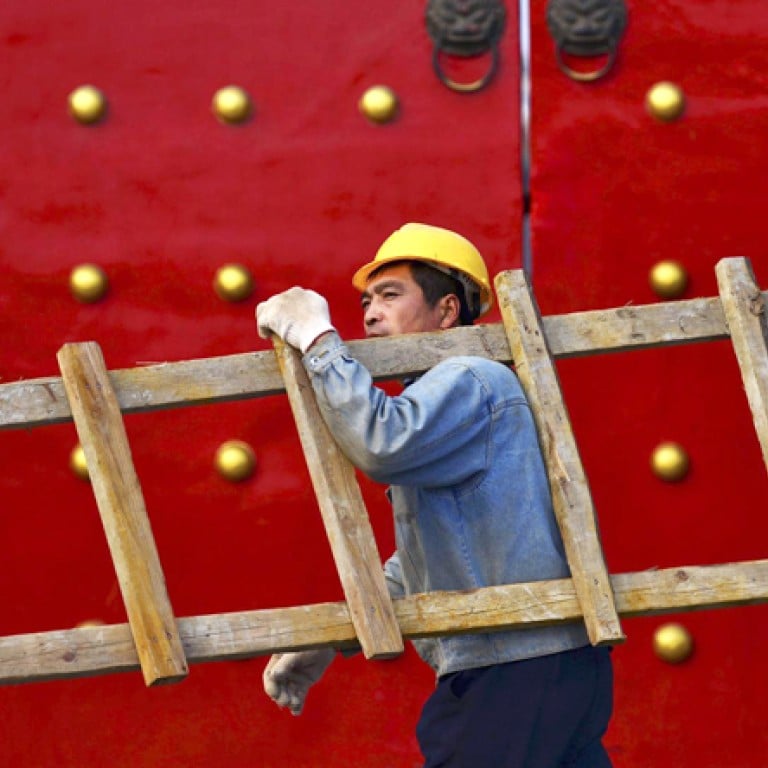
Growth targets ensure reliance on investment
While mainland authorities talk of the need for domestic shift, experts say Beijing lacks options
Like it or not, the mainland may have to keep depending on investment to drive growth if the government continues to target economic expansion of as much as 7 per cent over the next decade.

Since he took office in March, Li has stated that high investment growth would not be desirable, because it would fuel overcapacity, financial risks and inflation.
Structural reforms aimed at shifting the economy's reliance on investment towards a consumption-driven model are high on the agenda at the Communist Party leaders' four-day plenum that began on Saturday.
However, a string of data shows that investment's role in the economy in the past year has not decreased as desired, but instead has risen.
The data shows that capital spending contributed 55.8 per cent of gross domestic product growth in the first three quarters of this year, compared with 50.5 per cent a year earlier, while the contribution of end-consumption declined to 45.9 per cent from 55 per cent. Fixed-asset investment grew 20.1 per cent from a year earlier in the first 10 months of this year, figures at the weekend showed, maintaining the 20.2 per cent pace in the January-September period.
Michael Pettis, a senior associate at the Carnegie Endowment for International Peace, said relying on investment remained inevitable for China. "As of yet no credible alternatives to investment as a source of growth have been found," Pettis told the
While not a worry for his predecessors, another challenge facing Li is the shrinking workforce. The number of people aged between 15 and 60 on the mainland dropped for the first time last year, by 3.45 million, and although modest, given the population of 1.3 billion, the rate of decline is expected to accelerate until at least 2030.
The demographic shift is set to drag on GDP growth, not only in mainland China but in many Asian economies such as Japan, Hong Kong and South Korea.
"China's recent investment surge was a demographic necessity," Frederic Neumann, a co-head of Asian economic research at HSBC, wrote in a research note. "Capital spending as a share of GDP is simply too large for it to decline rapidly without hurting overall growth."
An older nation would mean fewer working people and lower output if productivity does not pick up quickly, which will lead to rising wage costs and falling competitiveness in labour-intensive sectors. HSBC estimated that in China a slowdown in the growth of the working-age population could shave about 0.5 percentage point off annual GDP growth.
"In the next few years, if Chinese officials want to maintain growth near or above 7 per cent, it will be necessary to maintain rapid investment growth," said Neumann.
Many researchers have called on Beijing to reduce its annual GDP target, noting that only in this way can provincial leaders shift their focus from chasing growth to tackling more fundamental problems, such as reforming the land system and expanding social welfare networks.
But to the country's leaders such a move would be politically risky as a sharp slowdown in economic growth might lead to lay-offs and fuel social unrest. Li stressed the importance of stabilising growth at a recent meeting. He said the mainland would need to maintain GDP growth of at least 7.2 per cent to ensure that the urban-registered jobless rate can stay at about 4 per cent.
Beijing has an official target for GDP to expand 7.5 per cent this year, a tad slower than the 7.8 per cent last year, which was the weakest pace in 13 years.
In July, to stem a continued slide in economic growth, the government decided to accelerate spending in areas such as subways and railways, helping GDP growth to rebound in the third quarter to 7.8 per cent from 7.5 per cent in the second and 7.7 per cent in the first.
Rather than seeking to slow investment at a time when a quick pickup in consumption remains a challenge, policymakers should think about raising the efficiency of the money spent, analysts say.
Pettis said Beijing needed to shift investment into more productive sectors, such as services, and small and medium-sized enterprises. Doing so would create more jobs and also help boost productivity because SMEs were usually "extremely efficient", compared with SOEs, he said.
The current investment model appears to be unsustainable. Easy credit to state-owned enterprises has pushed the mainland's debt to GDP ratio to as high as 200 per cent, with many industries suffering from excess capacity, such as steel and aluminium.
Yet the party's third plenum may disappoint many who are hoping for breakthroughs in certain difficult reform areas, such as trimming the power of the state sector, due to mounting objections from vested interests.
Another strategy that policymakers are pondering is to push ahead with urbanisation, in order to move millions of farmers from the countryside to become new urban workers, replenishing the shrinking labour force.
But that might be "only of temporary comfort", said Neumann. "The acceleration in ageing of the Chinese society will at some point overwhelm the urbanisation process, leaving growth vulnerable," he said.

